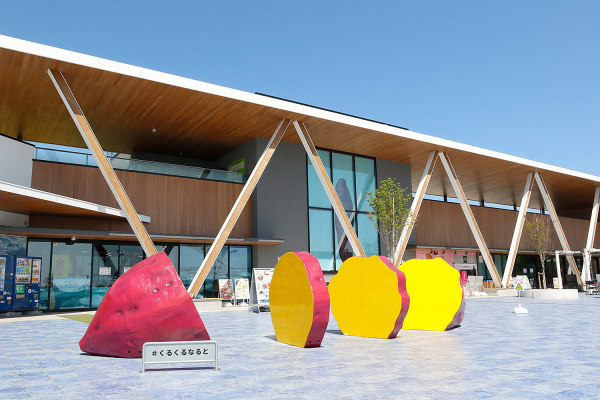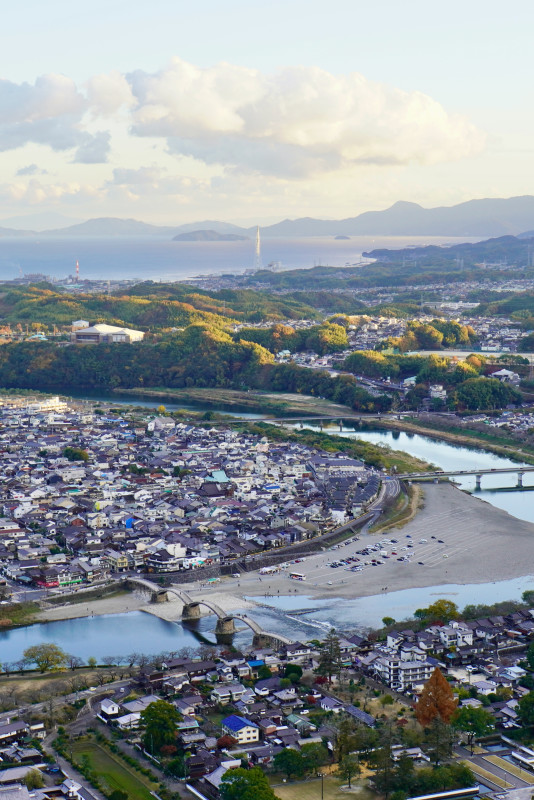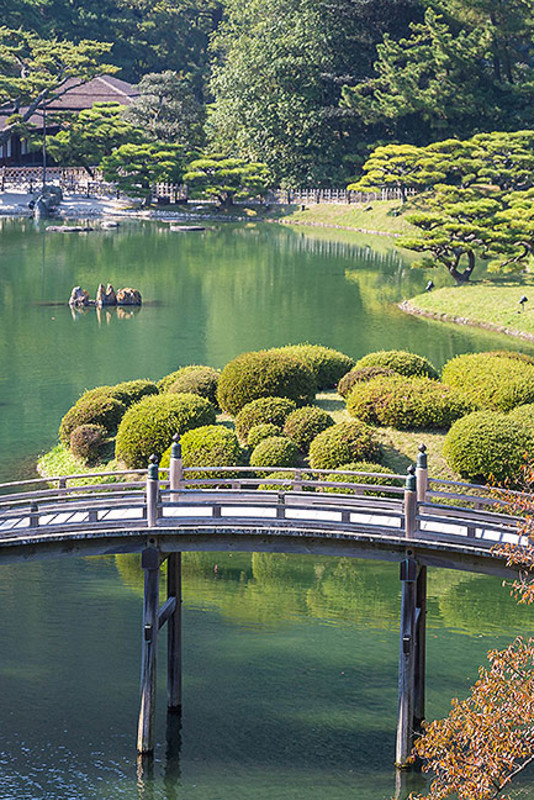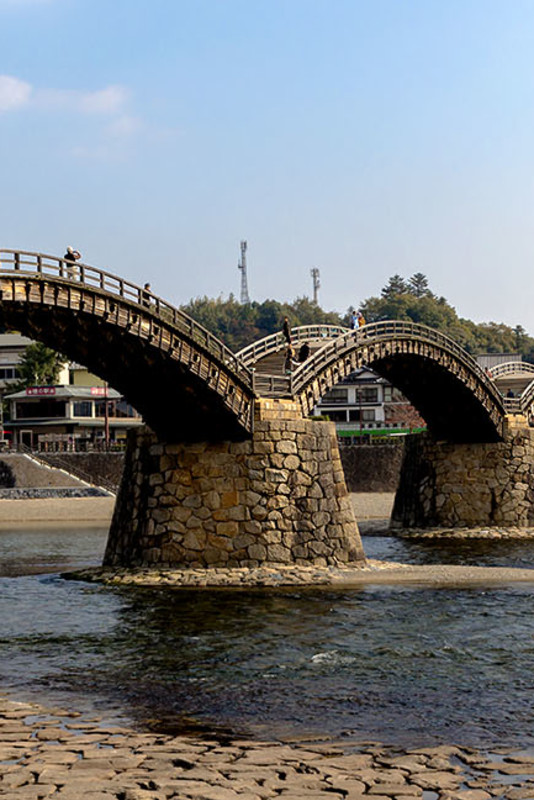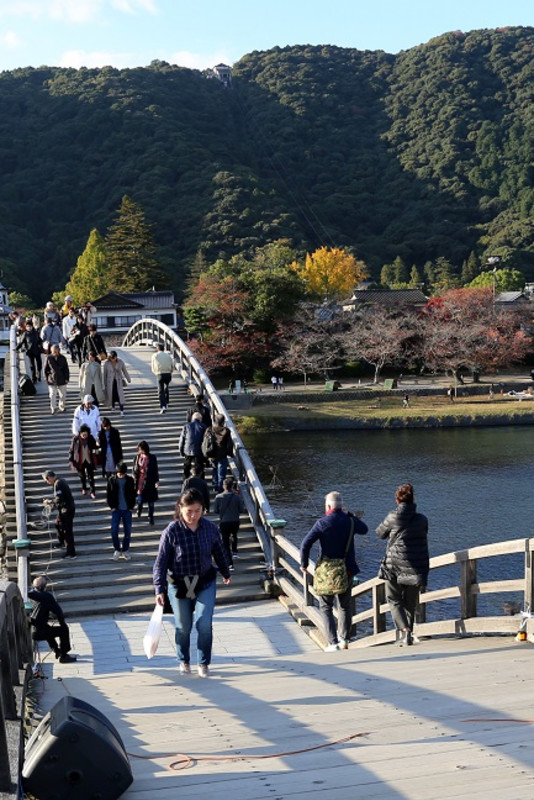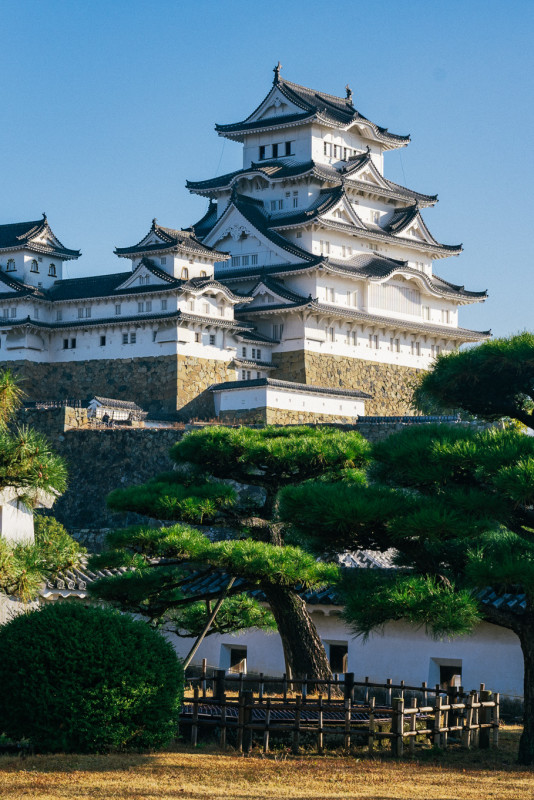Itineraries
Exciting Eastern Setouchi: Hot Springs, Samurai Castles and Gardens, Contemporary Art and Architecture

As well as popular destinations such as Kobe, Kurashiki and the art islands of Naoshima and Teshima, this five-day circuit of eastern Setouchi takes in the eclectic sights of Awaji Island and the off-the-beaten-track cultural highlights of Okayama Castle and Takamatsu’s Ritsurin Garden.
- Day 1
- Kobe and Arima Onsen
Travel: Osaka to Kobe
・Take the local train from Osaka Station to Sannomiya Station (Approx 30 minutes)
Spend the day exploring Kobe, considered to be one of Japan’s most cosmopolitan cities and home to the world's most famous beef, before checking in at a wonderful inn located in the ancient hot spring resort of Arima.
Explore the historic residences, cafes, and boutiques in the hillside streets of Kitano, home to foreign dignitaries and traders after Japan reopened to the world in the 19th century after over two hundred years of isolation.
A five-minute walk from Shin-Kobe Station the Kobe-Nunobiki Ropeway whisks you up to Kobe Nunobiki Herb Gardens. An expansive facility with 12 beautifully landscaped gardens, the views over Kobe from upper ropeway station are fantastic. Near the lower station is the highly-rated Takenaka Carpentry Tools Museum. Well-explained exhibits cover the history of Japanese woodworking from prehistoric times and provide visitors with knowledge and an appreciation of the craft that will enhance visits to temples, shrines, and other historic buildings, on this trip and beyond.
Experience the unparalleled culinary pleasure of Kobe Beef
Renowned worldwide for the exquisite tenderness and the rich flavor that comes from its impressive fat marbling, Kobe Beef originates from pedigree Tajima cattle exclusively born and raised in Hyogo Prefecture. Enjoying the artistry of teppanyaki, where skilled chefs expertly grill the beef on an iron plate right before your eyes is an unforgettable dining experience.
Mt Rokko and Arima Onsen
Mentioned in revered ancient texts, the popular hot spring resort of Arima Onsen is steeped in history and renowned for its therapeutic waters with diverse properties. Delight in the restorative brownish waters infused with salt and iron, revel in the radium (radon) springs rich in radium, or immerse yourself in the invigorating carbonated springs. In fact, seven out of the nine curative water types outlined by the Japan Ministry of the Environment, can be enjoyed in Arima, making for a truly exceptional bathing experience.
Arima Onsen can be accessed by local train, but, send your luggage ahead and you can make the journey by way of Mt Rokko via a series of cable cars and ropeways. This gives you the opportunity to enjoy the mountain leisure destination that became popular among Kobe’s international residents in the 19th century. The ridge has several visitor attractions and is famed for its “10 million dollar” night view and a captivating 12-minute journey on the Rokko-Arima Ropeway drop you in Arima, a short walk to your ryokan.
Accommodation: Arima Sansho Gosho Bessho Ryokan
Conveniently located a short walk from Arima Onsen Ropeway Station, Arima Sansho Gosho Bessho, is in a quieter part of the historic hot spring resort and feels very close to nature. From the privacy of your own villa, wonder at this tranquil enclave’s 500 year journey from temple to luxurious hotel. Revive yourself after your Mt Rokko excursion by soaking in the mineral-rich waters derived from ancient seawater. Indulge in an exquisite terroir dining experience, where traditional Yamaga cuisine takes center stage. Savor the impeccable flavors of the region’s abundant produce from mountain and sea, meticulously crafted by skilled artisans with a keen appreciation of Western sensibilities while offering a gastronomic adventure that truly captures the essence of Kobe and Arima's rich cultural heritage.
URL: http://goshobessho.com
- Day 2
- Awaji Island
Travel: Kobe to Awaji Island
・Take the Special Rapid Service from Sannomiya Station to Akashi Station, the gateway to Awaji Island (Approx 15 minutes)
・Awaji Island is best explored by rental car or chartered taxi.
Awaji Island
The largest of the Seto Inland Sea islands, Awaji is located conveniently close to Kobe (as well as Osaka and Kyoto) and it has an impressively eclectic range of attractions to offer the visitor. In addition to anime-related themed parks, you will find incredible architecture, gorgeous nature, laid back cafes serving great food and unique cultural heritage. Awaji Island is best explored by rental car or chartered taxi. Pick and choose from the options below to fit your interests.
Climb the Akashi Kaikyo Bridge
When the Akashi Kaikyo Bridge opened in 1998 linking Kobe on the mainland to Awaji Island, it had the longest span of any suspension bridge in the world. As well as its length, the enormous support towers on the Akashi Kaikyo Bridge rise an astounding 300m above sea level. You can ascend the towers if you sign up for the Bridge World tour run by bridge operators Honshu-Shikoku Bridge Expressway Company Ltd. This thrilling tour will take you underneath the road section and up the towers to the viewing platform at the top. The panoramic view from the platform is astounding. This is not recommended for anyone with a fear of heights!
URL: https://www.jb-honshi.co.jp/english/bridgeworld/
Zen Meditation at Zenbo Seinei
Designed by Pritzker Prize-winning architect Shigeru Ban, Zenbo Seinei is a Zen retreat and wellness facility on Awaji Island. The incredible wooden deck jutting out from a ridge removes the boundaries between you and the surrounding countryside. This is the perfect place to practice Zen meditation and realign yourself with nature. They also offer original, healthy, vegan “Zenbo Cuisine”, and accommodation options. They have different plans available so make sure to check their website before you go.
URL: https://zenbo-seinei.com
Awaji Yumebutai and Honpukuji Temple - Tadao Ando’s Architecture
The architecture of Tadao Ando, another Pritzker Prize winner, has become synonymous with the Setouchi and his works are dotted throughout the region. Awaji Island, however, boasts a high number of his architectural masterpieces.
Awaji Yumebutai incorporates a variety of themes and architectural concepts throughout an expansive development, which includes an international conference center and the hotel Grand Nikko Awaji (also designed by Ando) and observation terraces. Highlights include the Hyakudan-en Garden and Promenade Garden, a Greek-style open-air theater, and a greenhouse. The hotel also features the Church of the Sea with its impressive cross of light.
Honpukuji Temple - another of Ando’s masterpieces - is a 10-minute drive from Awaji Yumebutai. Known as the water temple, Honpukuji Temple appears as a large pond covered in water lilies – an important symbol in Buddhism. A narrow flight of steps descends through the center of the pond and leads to the main temple hall and altar.
Ayuya Waterfall
Down river from the scenic Aiyagawa Dam The enchanting Ayuya Waterfall is one of Awaji’s best kept secrets and a detour here will leave you feeling refreshed and rejuvenated. You can get near the waterfall for pictures, but take care because the footpath can get slippery.
Awaji Ningyo Joruri
Awaji puppet theater has a history stretching back to 1643 and most puppet theater styles in Japan can trace their origins to Awaji. This includes the famous Bunraku that was named after puppet master Uemura Bunrakuken who came from Awaji. Today, the best way to see a live performance is to visit the Awaji Puppet Theater (Awaji Ningyoza) in Minami Awaji. The theater has performances six days a week and offers backstage tours where you can see the puppets up close and learn how the puppeteers operate them.
URL: https://awajiningyoza.com/en/top/
Cafe culture on Awaji
With beautiful scenic coastlines and lush mountains, Awaji Island is not short for idyllic locations for cafes and restaurants. Miele is one of the island's most popular cafes and has a superb view of the Seto Inland Sea. Happy Pancake at Awajishima Terrace is another popular café on Awaji’s western coastline with superb views of the sea. The pancakes, drinks and atmosphere are delightful. No wonder it gets very busy at weekends and holidays! Rakutogama is a café, gallery and working pottery studio all rolled into one. Heavily involved in community initiatives, Rakutogama is the place to go if you want to connect and learn more about the island. Housed inside a renovated period building in Sumoto City, Farm Studio Café is the place to come to enjoy healthy meals and drinks made from the best local ingredients.
Awaji Beef and Awaji Onions
For a true taste of Awaji, make sure to try both Awaji’s beef and the island’s onions.
Awaji Island produces around 70% of Hyogo Prefecture’s Tajima beef cattle - with most going on to be sold as Kobe Beef. Since 1986, The Association for Awaji Beef Branding Promotion has been promoting Awaji Beef as a brand in its own right. To be sold under the Awaji brand, the beef must be from cattle born, bred, and processed on Awaji Island and pass a rigorous series of quality checks. This ensures any Awaji Beef you eat will be of the highest quality.
Awaji’s climate and rich mineral-laden soil is perfect for growing some of the finest onions in Japan. Awaji’s onions are renowned for their mild, sweet taste. The island’s chefs adore Awaji onions and their versatility. Depending on the variety, chefs use them raw in salads, caramelized in savory dishes, or incorporate them into traditional Japanese cuisine. The first varieties of onion to hit the shelves are usually the sweet shin-tamanegi. These are ready to be harvested around March and April, making this a great time of year to visit if you like your onions.
Accommodation: Hotel Ridge
Stay overnight at the Hotel Ridge, a secluded wellness resort with stunning views of the Naruto whirlpools and the Naruto Ohashi Bridge. Everything at Hotel Ridge has been curated to make your stay as relaxing as possible. The hotel suite’s minimalist design and unobstructed views of the Seto Inland Sea all add to the general feeling of serenity. At dinner, the attention to detail in the presentation of the kaiseki meal will take your breath away. Treat your tastebuds to an ensemble of fresh seasonal ingredients. Along with their natural hot spring spa, Hotel Ridge offers guests thalassotherapy massages and treatments that harness the soothing properties of the sea.
URL: https://hotelridge.jp
- Day 3
- Takamatsu and Naoshima
Travel: Tokushima to Takamatsu via Sanju Idatsu Yashiki
・Take the Uzushio Limited Express train from Tokushima JR Station to Takamatsu Station (Approx 1 hour 15 minutes)
・Get off at Hiketa Station to visit Sanju Idatsu Yashiki on the way to Takamatsu (Approx 30 minutes)
Sanju Izutsu Yashiki
7 minutes walk from Hiketa Station (on the way to Takamastu) is Sanju Izutsu Yashiki, a renovated former merchant residence and soy sauce and sake factory. The buildings, dating from the late Edo period (1603-1868), have been well preserved and are open to the public. Hands-on experience activities such as Wasanbon traditional sugar confectionery making and leathercraft are also available.
This part of Kagawa Prefecture has been a center of glove manufacturing since the late 19th century and around 90% of Japan’s gloves are still made here. Check out the nearby Glove Gallery, housed in one of the many traditional houses and stores that line the narrow streets.
Grab a coffee and toasted sandwich at Cafe Nouvelle Post, located in a former post office built in the 1930s, before continuing your journey to Takamatsu.
Ritsurin Garden
Enjoy traditional Japanese tea and a tranquil boat ride in Takamatsu’s world-renowned 400-year-old Ritsurin Garden. Famous for its picture postcard views and hundreds of well-manicured pine trees, Ritsurin Garden is designated as a Special Place of Scenic Beauty and received a glowing three-star review in the Michelin Green Guide Japan.
Travel: Takamatsu to Naoshima
・Take a ferry from Takamatsu Port to Miyaura Port on Naoshima (Car ferry 50 minutes, high speed passenger ferry 30 minutes)
・Find ferry information in English here
Chichu Art Museum, Benesse House Museum, Art House Project
People travel from far and wide to visit Naoshima – the most famous of Setouchi’s ‘Art Islands.’ Naoshima’s appeal is enriched by Tadao Ando’s unique architecture that houses so many of the artworks and museums. In the Chichu Art Museum, natural light and Tadao Ando’s architecture add another dimension to the masterpieces by Claude Monet, Walter De Maria, and James Turrell on display. The Benesse House Museum houses an incredible array of work by contemporary artists including works by Yayoi Kusama and Andy Warhol. Make sure you leave enough time to visit Naoshima’s Art House Project. This art initiative transforms traditional Japanese houses into art spaces.
Accommodation: Benesse House
Benesse House as it’s not only a museum but also a hotel and Benesse House Oval is the most luxurious of its four sections (the others being the Museum, Park and Beach)section. Accessible by a small monorail, it is located on top of a hill, and each room commands a sweeping view of the Seto Inland Sea and is decorated with original artworks. Hotel guests have the privilege to experience the Benesse House Museum after hours in a completely different atmosphere, when other visitors are gone, and the sun has set.
Issen, the Museum Restaurant will let you discover fine traditional Japanese cuisine centered around the local seafood and the Terrace Restaurant, located right by the Seto Inland Sea, gives local ingredients and French interpretation. End your day with a night visit to the Sugimoto Gallery or a walk by the sea surrounded by Nikki de Saint-Phalle sculptures and Kusama’s iconic “Pumpkin”.
URL: https://benesse-artsite.jp/en/stay/
- Day 4
- Teshima and Kurashiki
Travel: Naoshima to Teshima
・Take the ferry from Miyaura Port on Naoshima to Ieura Port on Teshima (Approx 20 minutes)
・Find ferry information in English here
Teshima Art Museum and Shima Kitchen
The result of a collaboration between artist Rei Naito and architect Ryue Nishizawa, Teshima Art Museum features a single, smooth concrete shell with no pillars. The oval windows create a bridge between the interior of the structure and the natural landscape outside. Your experience within the museum is influenced directly by the changing seasons and weather outside, meaning no two visits to the site will ever feel the same.
The restaurant Shima Kitchen aims to connect people through food and art. Shima Kitchen was created by architect Ryo Abe during the Setouchi International Art Festival 2010 and serves lunch on weekends, Mondays and public holidays. Run by local residents, it is a great place to feel the local community vibe. They also host regular performances and other events throughout the year. Make sure to check their website for opening hours and event information before you go.
Travel: Teshima to Kurashiki
・Take the ferry from Teshima to Uno Port (Car ferry approx 40 minutes, high speed passenger ferry approx 25 minutes)
・Take the local train to Kurashiki Station (Approx 20 minutes)
・Find ferry information in English here
La Malle de Bois
Continue the artistic theme by taking this retro-styled scenic train that makes the journey from Uno to Okayama on a limited number of days during the year. Should your visit coincide with one of these days, consider making a reservation and booking yourself a fresh seafood lunch box or sweets set to enjoy on your way to Okayama.
URL: https://www.jr-odekake.net/railrod/kankoutrain/area_okayama/lamalledebois/
Take an evening stroll around the Kurashiki Bikan Historical Quarter
Kurashiki prospered as a political and trade center after it came under the direct control of the Tokugawa Shogunate in 1642. Kurashiki’s fortune continued during the late 19th century and early 20th century, this time led by the textile industry. As the town escaped relatively unscathed in WWII, the mix of traditional Japanese and Western-style warehouses and mansions built along the Kurashiki River still remain. Today they are protected as part of the Bikan Historical District which attracts people from all around the world for a taste of the Japan of old. As night descends, the streets are illuminated and Kurashiki takes on a serene ambiance.
Accommodation: Ryokan Kurashiki
Ryokan Kurashiki, overlooking the canal that runs through the heart of Kurashiki’s historical district, is in one of the most picturesque locations in the district and is considered the best traditional Japanese inn experience in the area. Housed in a former sugar warehouse, all Ryokan Kurashiki’s eight rooms have a traditional architectural aesthetic with stylish accents and modern comforts such as low profile western beds. The Okuzashiki suite, tucked away within the depths of the ryokan, feels like staying in your own private villa. Exquisite seasonal kaiseki dinners, featuring the abundant produce of the Setouchi region, and beautifully presented breakfasts are a highlight. Use of a private onsen is also available by reservation.
URL: http://www.ryokan-kurashiki.jp/en/
- Day 5
- Kurashiki and Okayama
The Kurashiki Bikan Historical Quarter by day
Kurashiki’s historical quarter is not only expertly preserved, it is also quite lively. As well as museums such as the Ohara Museum of Art with its impressive collection of internationally acclaimed masterpieces, the Kurashiki Museum of Folkcraft and Kurashiki Archaeological Museum, a wide variety of shops, cafes and eateries, from traditional to trendy, occupy many of the traditional buildings. Ivy Square, a red brick facility on the site of a former cotton mill, offers a variety of workshop activities, including Bizenyaki pottery making, one of Japan’s oldest pottery styles. Walking from place to place passing through an historically preserved cityscape offers a fascinating and historically seamless transition from one attraction to the next.
Kurashiki Momoko
There are many places to eat around Kurashiki’s historical district, but, if you are looking for a refreshingly sweet treat, one in particular deserves a special mention. Kurashiki Momoko is very popular for its gorgeous and tasty parfaits, desserts and cakes featuring seasonal fruits, including many that are locally grown in Okayama Prefecture. Okayama’s mild climate and technical skill of its farmers have earned it the nickname of the “Kingdom of Fruit” and Kurashiki Momoko is a great place to sample some. There are four outlets to choose from, but the original “Sohonten” has an impressive collection of French Art Nouveau glassware by Émile Gallé on display.
Travel: Kurashiki to Okayama
・Take a local train from Kurashiki to Okayama (Approx 20 minutes)
Okayama Korakuen Garden & Okayama Castle
Okayama Korakuen Garden in central Okayama is considered to be one of the three great Japanese gardens. Built around 300 years ago on the order of the feudal lord Ikeda Tsunamasa, the garden was designed as a “strolling garden” where the view shifts and changes as you walk around. Okayama Castle, located across the river from the garden, is known as “Ujo” or “crow castle” due to its striking, black-paneled exterior. Take your time to explore the castle interior and the grounds. The area around Okayama Korakuen Garden and Okayama Castle is an oasis of calm in the heart of Okayama City.
Okayama Kakushi Sushi
During the Edo Period (1603-868), kakushi sushi (hidden sushi) was created by the people of Okayama to circumvent a decree by Okayama’s feudal lord Ikeda Narimasa that forbade people from placing extravagant toppings on bowls of rice. According to legend, people began hiding their delicious toppings of vegetables, shrimp, and fish underneath the rice. Japanese Restaurant Kibizen in Okayama maintains the tradition and offers authentic kakushi sushi. On first appearance, the wooden box appears to be just a layer of rice and finely shredded egg. However, flip the box upside down and you will reveal a hidden layer of delicious seasonal sashimi. The traditional dipping sauce made from pickled plums boiled in sake and dashi adds another layer of authenticity to the dish.
























































































